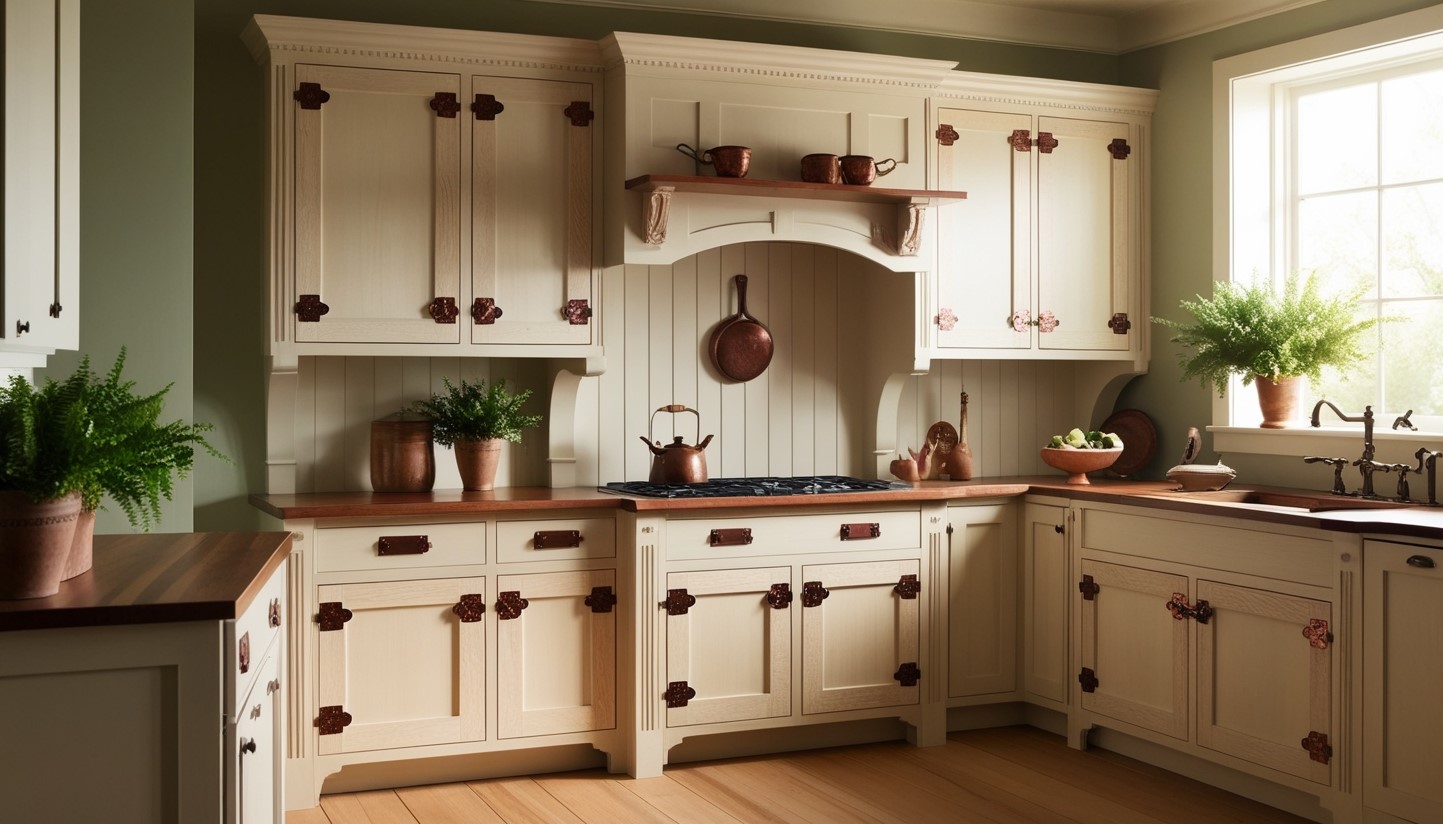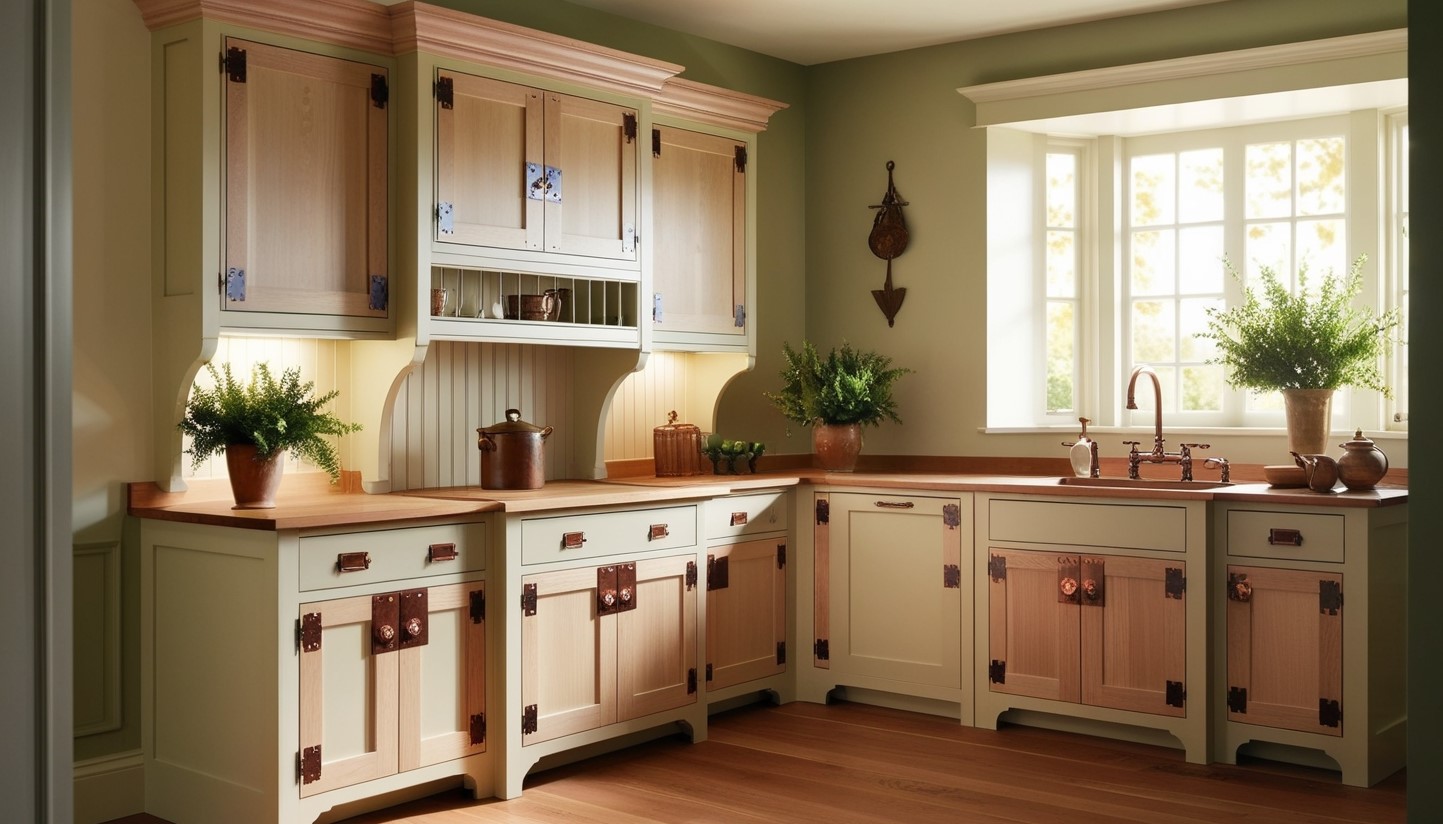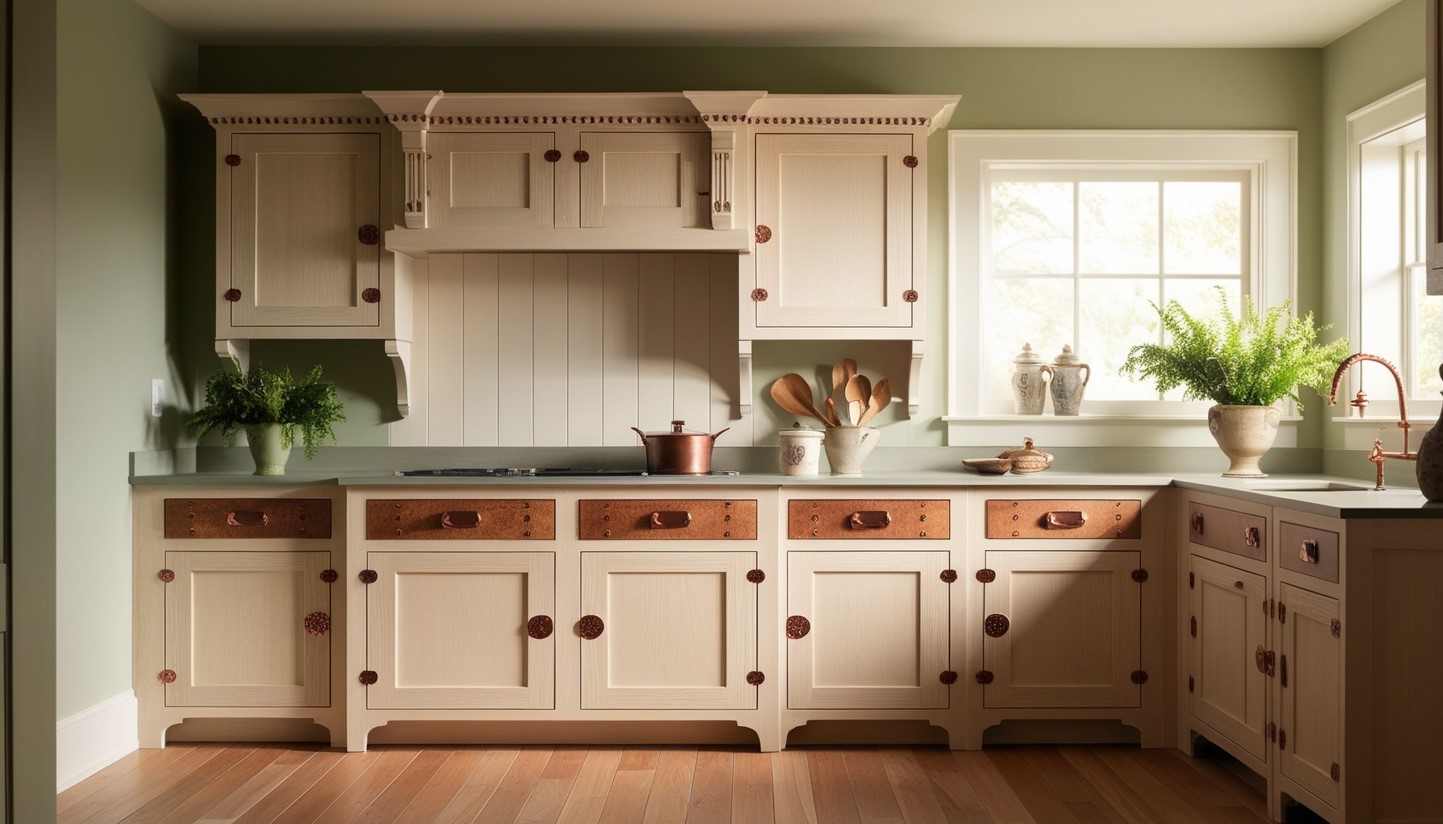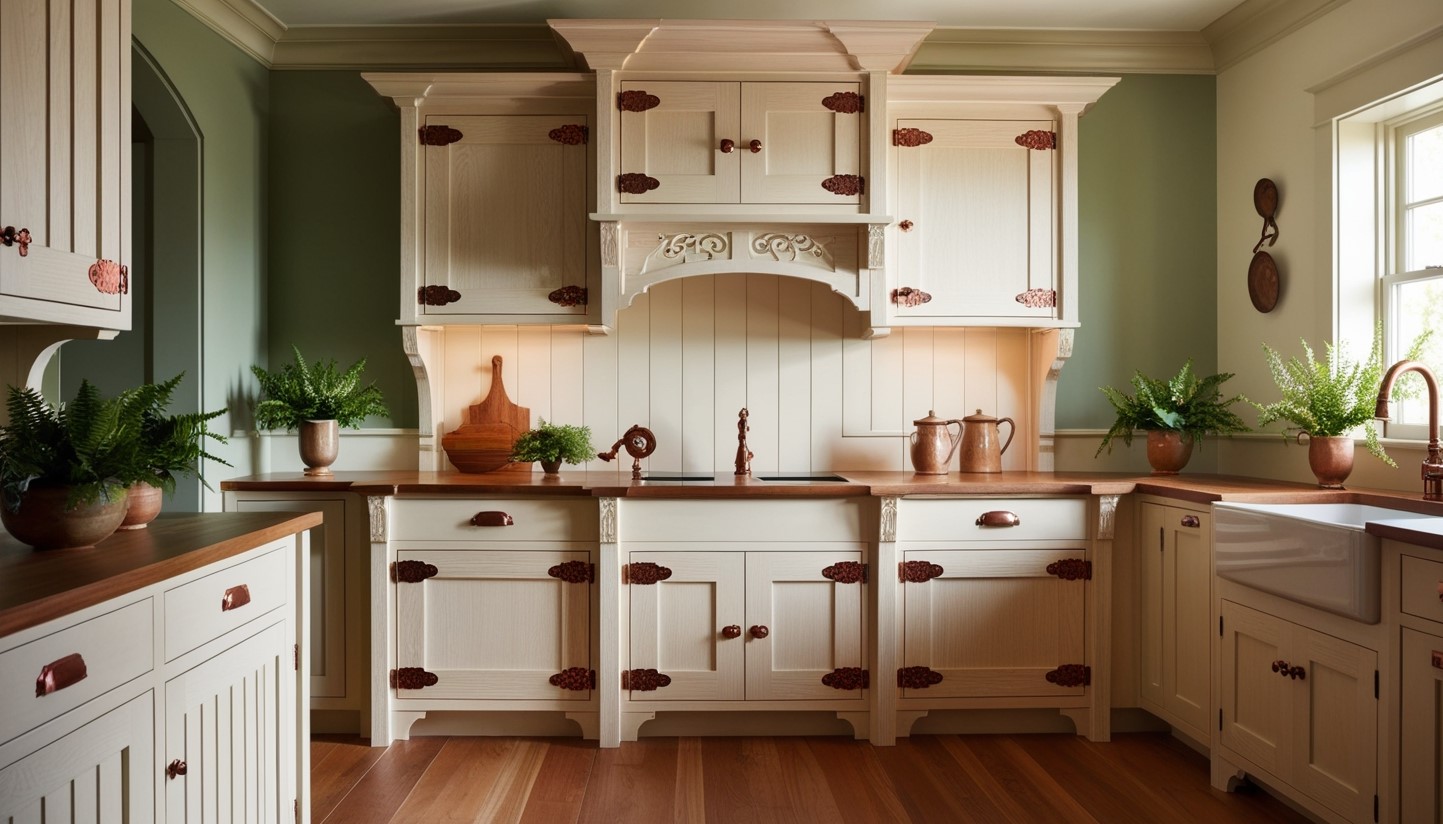The Arts and Crafts style, renowned for its focus on handcrafted beauty, simplicity, and functionality, has made a significant resurgence in modern kitchens. Arts and Crafts style kitchen cabinets evoke a sense of warmth, character, and timeless appeal. Rooted in the late 19th-century British and American design movements, this style emphasizes craftsmanship, natural materials, and minimalist yet inviting designs.
In this comprehensive guide, we will explore the defining characteristics of Arts and Crafts-style kitchen cabinets, how to incorporate them into your kitchen, and the best materials and colors to use, we’ll also answer frequently asked questions to help you create the perfect Arts and Crafts kitchen for your home.
Understanding the Arts and Crafts Style
Before discussing the specific elements of Arts and Crafts kitchen cabinets, it’s essential to understand the movement’s philosophy and core principles.
1. Handcrafted Beauty and Attention to Detail
At its core, the Arts and Crafts style is rooted in the belief that the best design is one that is both functional and beautiful, with an emphasis on handmade craftsmanship. This movement, which began in the late 19th century, reacted against the mass-produced, industrialized designs of the time and sought to bring back traditional, artisanal techniques in furniture and interior design. This focus on handcrafted quality is a hallmark of Arts and Crafts kitchen cabinets, where every piece is thoughtfully designed and meticulously crafted.
2. Simplicity and Functionality
While the Arts and Crafts style celebrates craftsmanship, it also values simplicity and practicality. Unlike more ornate styles, Arts and Crafts kitchen cabinets tend to feature clean lines, straightforward shapes, and a lack of excessive decoration. This style prioritizes functionality and ease of use, ensuring that the cabinetry meets everyday needs without compromising on aesthetics.
3. Natural Materials and Earthy Tones
The Arts and Crafts movement celebrates the use of natural materials such as wood, stone, and metal. In kitchen cabinets, this often translates to rich, warm wood tones like oak, cherry, or maple. These materials are typically left in their natural state or lightly stained to enhance their grain and texture. The use of earthy, muted tones helps create a grounded, organic atmosphere in the kitchen.

Key Features of Arts and Crafts Style Kitchen Cabinets
Now that we have an understanding of the general principles of Arts and Crafts design, let’s explore the specific features of Arts and Crafts style kitchen cabinets.
1. Simple, Rectilinear Designs
Arts and Crafts style kitchen cabinets feature simple, geometric shapes and clean lines. Cabinets tend to have flat panels with minimal decoration, often featuring square or rectangular door frames. The focus is on form and functionality, with an emphasis on proportion and balance.
2. Visible Joinery
One of the defining features of Arts and Crafts kitchen cabinets is the visible joinery. In this style, the craftsmanship is meant to be showcased, so joints and corners are often exposed. This could include dovetail joints, mortise-and-tenon joints, or other traditional woodworking techniques that highlight the skill of the maker. These visible joints add a sense of authenticity and handcraft to the cabinets.
3. Heavy, Solid Wood Construction
Arts and Crafts style kitchen cabinets are built to last, with a strong emphasis on solid wood construction. The use of hardwoods like oak, walnut, or cherry is everyday, as these materials not only provide durability but also showcase the natural beauty of the wood grain. The sturdy, substantial feel of these cabinets adds to the overall sense of quality and permanence that the Arts and Crafts style aims to convey.
4. Minimal Ornamentation
While the Arts and Crafts style does include decorative elements, they tend to be understated and purposeful. Instead of elaborate carvings or intricate moldings, Arts and Crafts kitchen cabinets typically feature simple, functional details like square knobs, flat-panel doors, and subtle relief patterns. The goal is to create beauty through craftsmanship and material choice, rather than through excessive ornamentation.
5. Natural Finish or Light Staining
In keeping with the movement’s emphasis on natural materials, Arts and Crafts kitchen cabinets are often left with a natural finish or lightly stained to showcase the wood’s inherent beauty. Darker stains, such as a deep mahogany or walnut finish, are common, but lighter stains like golden oak or honey maple are also popular. The finish is typically matte or satin, providing a warm, soft glow that highlights the grain of the wood.

Materials for Arts and Crafts Style Kitchen Cabinets
The materials used in Arts and Crafts style kitchen cabinets are essential to achieving the timeless look and feel associated with the movement. Below are some of the best materials for Arts and Crafts kitchen cabinetry.
1. Solid Wood
Solid wood is the cornerstone of the Arts and Crafts style. It’s used for both the cabinet frames and doors, and it provides the warmth, texture, and longevity that the style is known for. Oak, in particular, is a popular choice due to its grain pattern, which lends itself well to the understated beauty of Arts and Crafts design.
2. Glass Insets
Many Arts and Crafts kitchen cabinets feature glass-inset doors, but they are typically kept simple. The glass used is often frosted or clear, and the door frames may be made of wood with simple, straight lines. The glass adds a touch of lightness without detracting from the simplicity of the design.
3. Handcrafted Hardware
The hardware used in Arts and Crafts kitchen cabinets is typically made of wrought iron, bronze, or brass. The handles and knobs are often square or rectangular, with simple geometric shapes and no excess ornamentation. This hardware is designed to complement the handcrafted nature of the cabinets and blend seamlessly with the overall design.
4. Stone and Tile Accents
While wood is the dominant material, stone and tile accents are often incorporated into the overall kitchen design. For example, a stone countertop or a tile backsplash can add a touch of natural texture and complement the rich tones of the wood cabinets. These materials help to create a balanced, earthy aesthetic in the kitchen.
How to Incorporate Arts and Crafts Style Kitchen Cabinets
If you’re looking to incorporate Arts and Crafts-style kitchen cabinets into your space, here are some tips to help you achieve the perfect look.
1. Choose the Right Wood
When selecting wood for your Arts and Crafts kitchen cabinets, opt for hardwoods like oak, walnut, or cherry. Oak is particularly popular due to its grain pattern and ability to take stains well. Be sure to choose a wood finish that complements the overall style of your kitchen, whether that’s a rich, dark stain or a lighter, more natural look.
2. Keep the Colors Neutral
Arts and Crafts design typically favors neutral, earthy tones. When choosing cabinet colors, stick to natural wood finishes or muted tones like olive green, deep brown, or warm beige. These colors will create a warm, inviting atmosphere and complement the handcrafted details of the cabinets.
3. Integrate Handcrafted Elements
To fully embrace the Arts and Crafts aesthetic, incorporate handcrafted elements throughout your kitchen. This could include custom cabinetry, artisanal tiles, or unique stone countertops. Every detail should contribute to the overall sense of craftsmanship and quality.
4. Add Decorative, Yet Simple Touches
While the Arts and Crafts style is characterized by minimalism, you can still add decorative touches that reflect the movement’s love of simple beauty. Consider adding elements like custom wooden shelves, hand-forged hardware, or a patterned tile backsplash.
5. Incorporate Natural Light
Maximize natural light in your kitchen to showcase the rich tones of your Arts and Crafts kitchen cabinets. Use large windows, open shelving, or glass-fronted cabinets to allow light to filter through the space. The natural light will highlight the craftsmanship of the cabinetry and create a warm, inviting atmosphere.

FAQs About Arts and Crafts Style Kitchen Cabinets
What is the main characteristic of Arts and Crafts kitchen cabinets?
Arts and Crafts kitchen cabinets are known for their simplicity, solid wood construction, visible joinery, and emphasis on handcrafted details. The style prioritizes functionality and understated beauty.
What materials are best for Arts and Crafts style cabinets?
The best materials for Arts and Crafts style cabinets include solid wood (such as oak, walnut, or cherry), handcrafted hardware made of wrought iron or bronze, and natural stone or tile accents for countertops and backsplashes.
Are Arts and Crafts kitchen cabinets still popular today?
Yes, Arts and Crafts kitchen cabinets are still highly popular today. Their timeless appeal, focus on craftsmanship, and ability to blend seamlessly with modern and traditional kitchen designs make them a top choice for homeowners.
How can I modernize an Arts and Crafts style kitchen?
To modernize an Arts and Crafts style kitchen, consider incorporating contemporary lighting, sleek appliances, or minimalist hardware while maintaining the handcrafted details and natural materials that define the style.
What is the best wood for Arts and Crafts cabinets?
Oak is one of the most popular wood choices for Arts and Crafts kitchen cabinets due to its durability, beautiful grain pattern, and ability to take stains well. Other hardwoods like walnut and cherry are also excellent choices.
Conclusion
Arts and Crafts style kitchen cabinets offer a timeless and elegant option for those looking to incorporate craftsmanship, natural beauty, and simplicity into their kitchen design. By focusing on solid wood materials, subtle detailing, and functionality, this style creates a warm and inviting kitchen that will never go out of style. Whether you’re renovating your existing kitchen or designing a new one, Arts and Crafts cabinets are an excellent choice for creating a space that reflects your style while honoring the legacy of this historic design movement.

